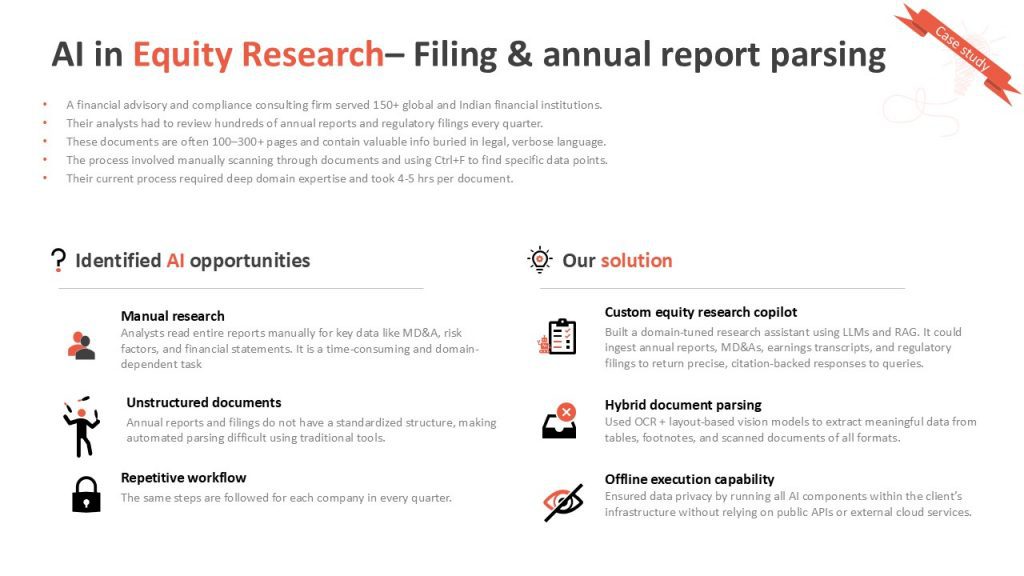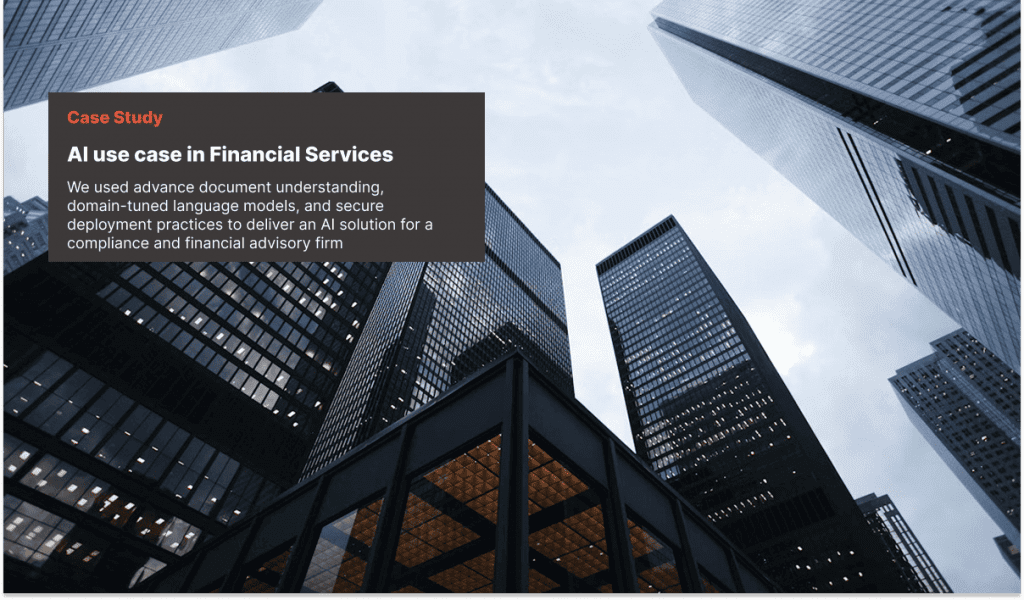We built a secure, AI-powered equity research copilot for a financial advisory firm that delivers fast, accurate insights from unstructured financial documents using LLMs and hybrid document parsing.

Executive Summary
A leading compliance and financial advisory firm that served over 150 global and Indian institutions was facing a major efficiency problem. Their analysts spent hours digging through hundreds of annual reports and regulatory filings each quarter. These documents were long, unstructured, and dense—filled with legal language and key financial data buried deep in the text.
To improve speed and accuracy, we built a custom AI research assistant. It helps analysts quickly extract relevant information from large documents and answer domain-specific queries with traceable citations. It resulted in research process that’s 70% faster, without compromising on precision or compliance.
Challenges in equity research
While the client had a well-trained team of analysts, their workflow was heavily manual and operationally inefficient. Our discovery sessions with their analysts and compliance managers revealed several critical bottlenecks:
Manual document review: Each quarter, analysts had to review hundreds of documents ranging from annual reports to regulatory filings. These documents were often over 100 pages long and written in legal and financial jargon. Key data like risk factors, MD&A insights, and audit notes were buried deep within unstructured sections. Finding even a single line of relevant information required hours of careful reading.
Unstructured document formats in companies: There was no standard layout or format for the documents. Some were well-structured PDFs, while others were scanned copies with annotations or complex tables. Even among companies in the same sector, the way data was presented varied widely. This inconsistency made traditional automation tools unreliable or unusable.
Information hidden in footnotes and tables: A lot of critical information, such as segment-wise revenues, debt covenants, or risk disclaimers, was stored in footnotes or embedded deep inside complex tables. These sections were particularly hard to parse or extract accurately using basic text search or PDF parsers.
Heavy reliance on domain expertise: Due to the language in these reports, interpretation often depended on the analyst’s experience. Junior analysts needed months of training to become proficient in identifying the right sections and reading between the lines. This made the process inconsistent, slow, and hard to scale during peak reporting periods.
Repetitive tasks: Despite the complexity, many parts of the research workflow were repetitive. Every analyst followed the same steps: download the report, search for specific sections using Ctrl+F, copy data into spreadsheets, summarize findings, and manually cite sources. This routine consumed most of their day and left little room for value-added analysis.
An important consideration was that of security and compliance. The client’s work involved handling sensitive financial information for global institutions. Using any AI tool that transmitted data to external servers was a strict no-go. They needed a solution that could work entirely within their infrastructure without compromising performance or privacy.
Our approach
After mapping out the pain points across the client’s research workflow, we designed a custom-built, domain-specific AI system that could automate the most time-consuming and repetitive parts of financial document analysis without compromising on accuracy, security, or interpretability.
Key features of our solution:
1. Domain-tuned research copilot using LLM + RAG: We developed a research assistant tailored to the financial services domain. Unlike generic chatbots, this system was fine-tuned to understand the structure and language of financial documents like:
- Annual reports
- MD&A (Management Discussion and Analysis) sections
- Regulatory filings
- Investor presentations
- Earnings transcripts
Analysts could ask natural-language questions such as: “What were the key risk disclosures in Q3 for Company X?” or “Summarize the change in segment revenues YoY.” The AI returned precise, citation-backed answers with reference snippets and page numbers from the source documents. This turned a 4-hour manual search task into a 15-minute interaction.
2. Hybrid document parsing for unstructured inputs: To deal with the wide variety of file formats and structures, we used a hybrid document intelligence approach:
- OCR for scanned PDFs
- Layout-aware vision models to interpret tables, sidebars, and footnotes
- Custom parsing rules for standard headers, regulatory boilerplates, and commonly used templates
This allowed us to accurately extract structured data even from low-quality scans or documents with inconsistent formatting.
3. Offline deployment for complete data privacy: Given the sensitivity of financial data, cloud-based APIs were not an option. We containerized the entire AI stack including the LLM, document retriever, vector store, and parser and deployed it securely within the client’s on-premise infrastructure.
- No data left their internal network
- The solution worked offline, with minimal latency
- Updates to the model and retriever could be pushed through controlled release cycles
This ensured the client remained fully compliant with their internal security and governance policies.
4. Citation-based responses with full traceability: To build trust among senior analysts and compliance reviewers, the system was designed to never “hallucinate.” Every output included:
- The exact excerpt from the source document
- A page number or section title
- A confidence score based on retrieval rank
Analysts could click to verify the answer and cross-check it in the original PDF. This traceability was crucial for internal audits and decision-making.
Results achieved:
By integrating this AI-powered research system into the client’s workflow, we saw measurable improvements across multiple dimensions:
80% reduction in manual review time: Analysts who previously spent 4–5 hours per report were now able to extract key insights in minutes.
Higher throughput with the same team size: The firm could handle more reports per quarter without hiring additional analysts, directly improving operational efficiency.
Improved accuracy and compliance: With citation-backed answers and traceable data points, AI reduced oversight risks and enabled better documentation for audit trails.
Faster onboarding of new analysts: Junior team members could use the AI to assist in complex analysis tasks, helping them ramp up faster and reduce dependence on tribal knowledge.
No compromise on data privacy: The offline deployment meant that none of the confidential financial data left the firm’s internal network, satisfying both internal policies and client expectations.
Conclusion
This project proved that with the right architecture, even complex, unstructured, and domain-heavy workflows like equity research can be transformed using AI. Instead of replacing analysts, our system became a powerful co-pilot, enabling faster decisions, reducing fatigue, and raising the overall quality of research.
By combining advanced document understanding, domain-tuned language models, and secure deployment practices, we delivered a solution that not only worked well inside high-stakes, regulated environments.
Ready to transform your business with AI?
Our AI solutions are built to scale with your business. To explore custom AI solutions, contact us or book a free consultation with our founder and AI strategist.

Great insights on AI’s role in decision-making-tyy.AI Tools really shines by curating top solutions like AI Chat tools for professionals seeking efficiency and innovation.
Great insights on AI’s role in decision-making-tyy.AI Tools really shines by curating top solutions like AI Chat tools for professionals seeking efficiency and innovation.